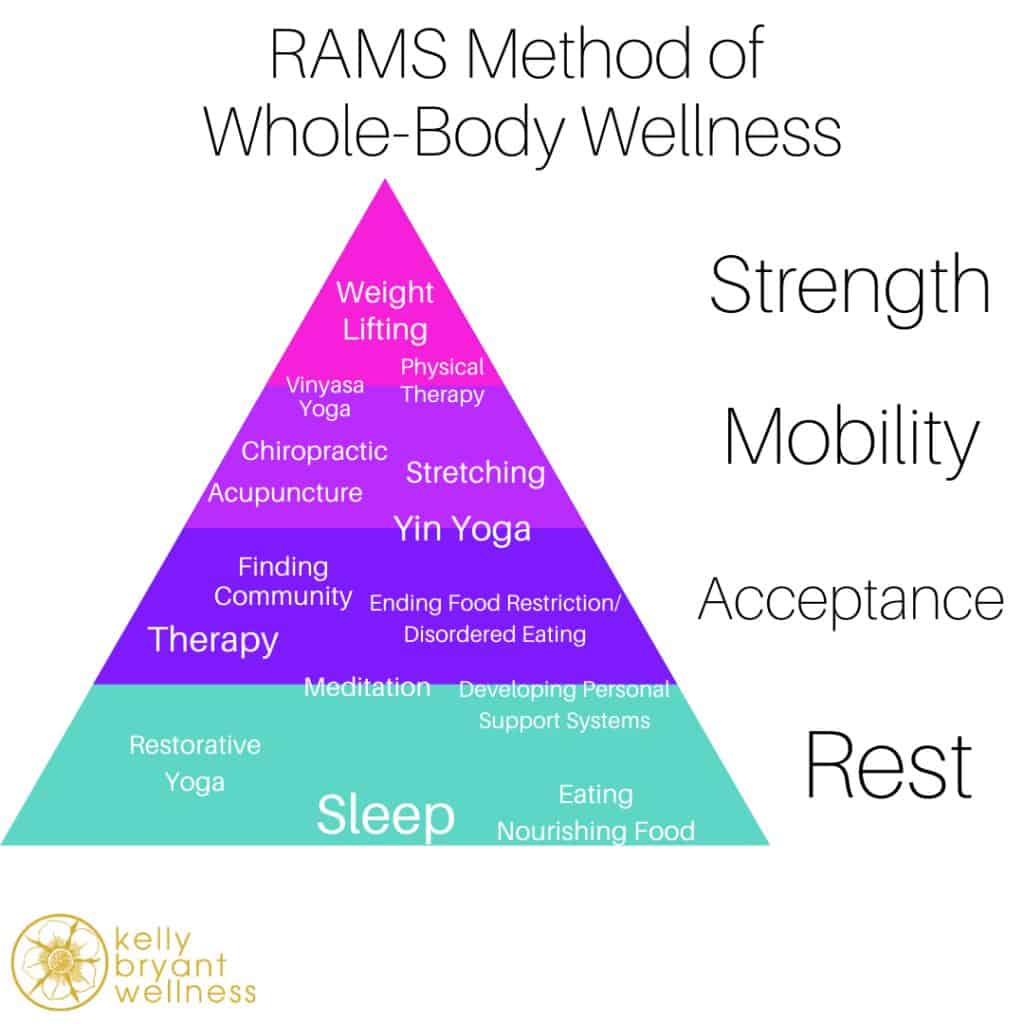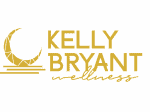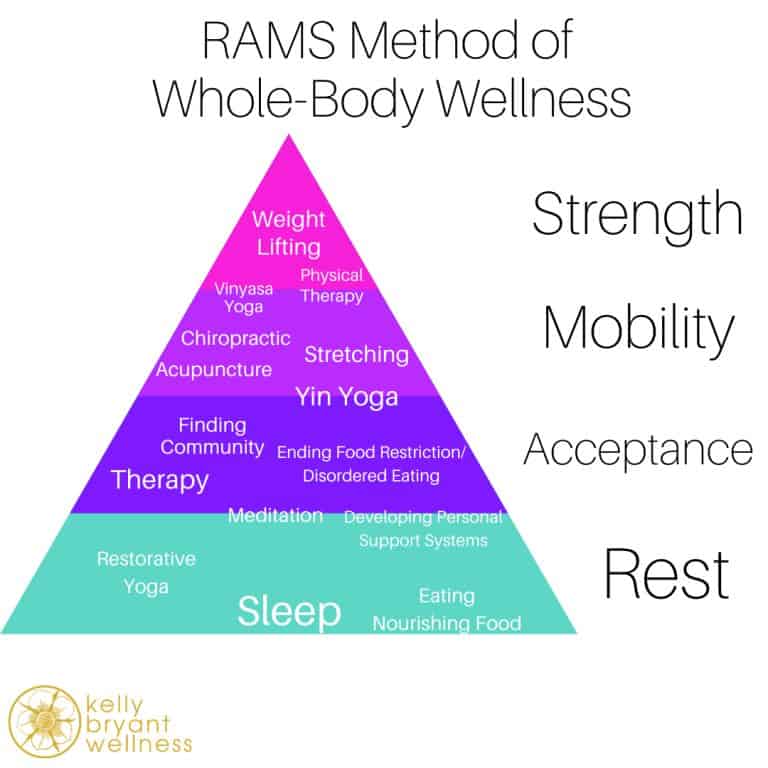Let me just start by saying I HATE the word wellness. We’ve used it to the point that it basically means nothing… like, if a company that makes spandex pants can call itself a wellness brand, I feel like we’re not talking about the same thing.
What is Wellness?
So, let’s start by talking about what I do mean when I say wellness. Wellness, to me, is a whole-person thing. It’s not just about your weight or your appearance or your stress level. It might encompass all of those things, but it’s also so much more.
- Wellness is our ability to feel grounded, centered, and in control of our life and our bodies.
- It’s our ability to be flexible and fluid both physically and psychologically.
- It’s our strength and our confidence.
- It’s our ability to open ourselves up to others emotionally and accept emotional support as well.
- It’s our ability to vocalize our experiences.
- And it’s our resilience in our minds and our bodies.
Yes, all of these things have to do with whether or not we are ill — and when we are ill, our ability to navigate that illness. But they also have to do with whether or not we feel well, which is different from feeling happy all the time.
For me, physical practices like yoga and strength-training provided a lot of those things for me — but as I deepen my own studies and work with others, I realize how intricately connected our brain, heart, gut, and body truly are. And, that there’s more than one way to access our greatest wellness.

What is the RAMS Method?
In short, Rest, Acceptance, Mobility, and Strength (RAMS) is my proprietary formula for helping clients reach their highest wellness, whether their specific goal has to do with health outcomes, pain management, or how they look and feel in their bodies.
RAMS is based on the idea of Maslow’s Hierarchy — but it’s oriented toward your wellness vs. your psychological self-actualization. The other big difference is that Maslow puts physical needs at the bottom of the pyramid (so do I), but he doesn’t address physical self-improvement — only emotional or psychological self-improvement.
The mistake most people make is that they start with self-improvement at the top of the pyramid, by starting a weight lifting program, or maybe a group fitness class. The problem is, the pyramid has to be built from the bottom up, or you don’t get the results you’re looking for.
For example, if you’re a new mom waking up multiple times per night to feed a baby, and you’re dragging yourself out of bed at 6AM to strength-train, you’re going to get injured, exhausted, discouraged, and struggle with recovery, because your body needs rest above all else. So, let’s break the pyramid down from bottom to top.
Rest
Rest refers to the baseline physiological needs of your body, including sleep, nourishing food, drinking water, etc. Within the category of rest are also physical practices, like restorative yoga and meditation (which bridges Rest and Acceptance) that help support sleep.
I don’t know how things were in Maslow’s day, but sleep is seriously under-appreciated amongst my clients. But the reality is that unless it’s nourished and rested, your body can. not. do the work of recovering from physical activity. It’s the most important part of any program, and I want my clients doing that above all else.
I also think it’s important to note here, that socio-economic factors like race and income play an enormous role in both your Rest and Acceptance categories. If you’re afraid for your physical safety every time you walk out your door, your body cannot perform at its highest level. The nervous system can’t sustain heightened stress forever, and ultimately the body breaks down. There’s evidence that race-related stress from racism is one factor impacting health outcomes for people of color.
If you are a POC, this makes creating community and support structures (see below) even more important. And if you are a white person who is passionate about improving quality of life (or health outcomes, or economic outcomes, or whatever) for all humans, this means that you also have a responsibility to use your privilege to improve conditions for POC. In short, vote, demonstrate, sign petitions, call your elected officials, give up your seat at the table, get involved.
Acceptance
Acceptance explicitly refers to self-acceptance, but it also encapsulates stress management, body positivity, acceptance of reality and the world as it is, and what the yogis call “equanimity.”
“Equanimity,” is a state of even-minded openness that allows for a balanced, clear response to all situations, rather than a response borne of reactivity or emotion.
There are physical practices, like meditation and Yin Yoga, that help to nurture acceptance, but therapy and emotional coaching are the top tools in this category.
I also consider finding your community and creating support structures in your life (like child care, house keeping help, personal organization, time management, and fair distribution of responsibilities between partners) to be part of acceptance, too, and studies have shown that these measures help reduce stress levels and also reduce disease.
Mobility
Mobility is exactly what it sounds like! The ability of your body to move through the joints full range of motion, or in other words, your ability to move the way your body was designed.
FAR too many people prioritize strength over mobility — treating stretching and foam rolling as a little side thing you do for a few minutes before or after the workout (if you feel like it). The truth is that stretching, mobility exercise, and complementary therapies like physical therapy, acupuncture, and chiropractic are much more important. If you don’t have access to your full range of motion, chances are fairly high that you’ll get injured.
Some movement practices (honestly, most movement practices, really) integrate both strength and mobility, but you still want to be sure you’re doing some things without weight and without the intent of building muscle.
Strength
Strength is exactly what it sounds like: practices like weight lifting and load-bearing exercises. These help with a huge number of other health issues and physical goals — like postpartum recovery, maintaining bone density, increasing resting metabolism, and simply being able to lift things and do these daily activities of your life.
Strength work is exciting — it feels empowering and it’s inspiring to see your body grow stronger. But the truth is, if you aren’t creating support at each lower level of the pyramid, you’ll never be happy with your results:
- If you lack rest, you won’t have the stamina to sustain.
- If you lack acceptance, no amount of physical improvements will make you happy.
- If you lack mobility, strength work will cause injury.
Are you ready to get started at the bottom of the pyramid and work your way up? Let’s work together. Learn more about personal training or schedule a consult here.

